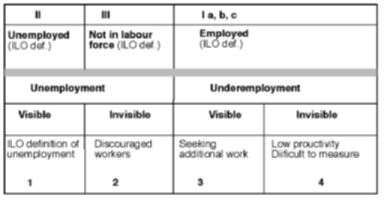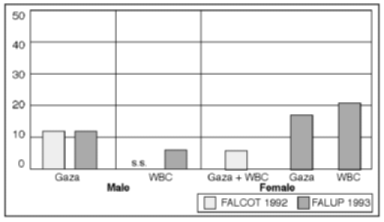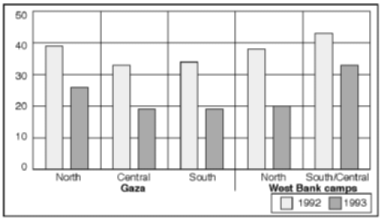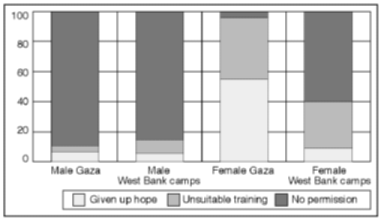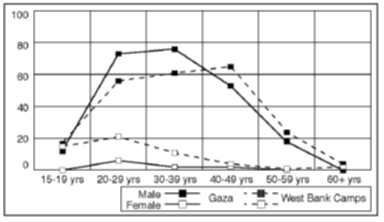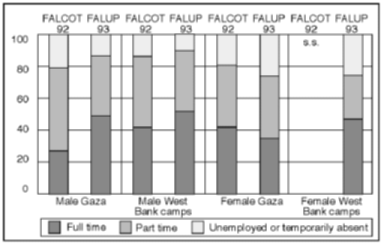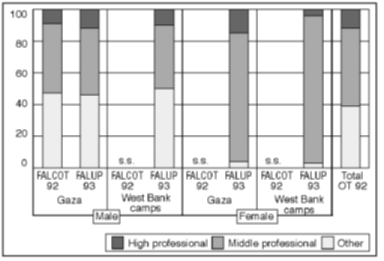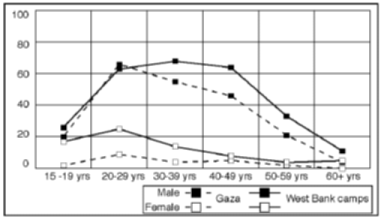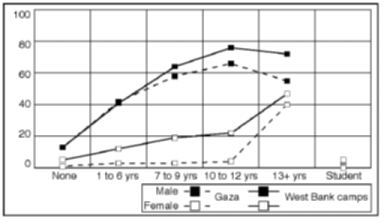
|
|
(Chapter 2) Under-utilization of labour The main aim of this section is to investigate the employment effects of the border closure. What has happened to those who have left the labour force? How does loss of employment manifest itself when measured according to ILO definitions for labour market statistics? Have, for example, the unemployment rates surged, or do other indicators give a more valid expression of present conditions in the labour market? Using the FALCOT 92 report as a baseline, we shall discuss the prevalence of various types of under-utilization of labour in Gaza and the West Bank refugee camps as of autumn 1993. If the present extraordinary low labour-force participation is a result of structural factors outside the control of the individual, it indicates a deterioration in welfare and living conditions. We will argue that the change in adult male labour-force participation is most probably rooted in the difficult labour market situation currently prevailing in the Occupied Territories. The apparently involuntary character of the situation would seem to validate claims of an under-utilized labour potential. Before proceeding with the discussion, some definitions and concepts must be clarified. Figure 2.10 gives a schematic overview of different types of under-utilization of labour. Note that the figure is based on the ILO classification system presented in figure 2.1. 3 In the FALCOT 92 report it was argued that unemployment rates were misleading as measures of the prevalence of under-utilization of labour in the Occupied Territories, for two main reasons. First, many "employed" persons in the labour force are in reality under-employed. Second, many persons outside the labour force can be labelled :discouraged workers" because they have simply given up trying to find work. In the survey, "discouraged workers" were identified as persons currently neither working nor seeking work, but who would like to work if an "acceptable" job for an "acceptable wage" could be found.
Figure 2.10 Types of labour under-utilization. In addition to the persons completely out of work - the regular "unemployed" - many employed persons also desire additional employment. These persons may be labelled visibly under-employed. Further, many workers are full-time employed in jobs with very low-productivity and wages. These workers can be characterized as invisibly under-employed. Finally, many persons outside the labour force are in reality so-called discouraged workers because they have simply given up trying to find work at all. See tables 2.12 to 2.17 in appendix 3 as references to the discussion in this section. "Unemployed" persons (box II) are defined by the ILO as those who did not work as much as one hour during the week prior to the interview, but who at the same time were actively seeking work. The state of unemployment may be considered as one extreme on a continuous scale from high labour activity to complete inactivity in the labour market. Figure 2.11 presents visible unemployment by gender and main area as share of the labour-force participants in each group. The 1992 unemployment rate as measured by the FALCOT 92 report has been used as a reference for Gaza males.
Figure 2.11 Unemployment rates, by gender and main geographical area (ILO definitions). Percentage of labour-force participants in respective groups From figure 2.11 we see that 1993 male unemployment rates in Gaza are higher than in the West Bank refugee camps. In both main areas, unemployment is higher for women than for men, which may indicate particularly strict requirements as to "acceptable" workplace and type of work for women. The critical question concerning unemployment is why the general 1993 visible unemployment rates in Gaza and the West Bank refugee camps are in fact so much lower than many might have expected. The March 1993 border closure could have been expected to generate a steep increase in unemployment rates in the short term. First, there is a direct effect of workers losing employment in Israel. Second, workers' loss of income induces negative domestic multiplier effects on aggregate demand. From figure 2.11, we see that unemployment in Gaza as of late 1993 is, however, the same as measured by the FALCOT 92 report. (The sample size for the West Bank refugee camps in the FALCOT 92 report is too small to permit comparison.) Several hypotheses may be suggested to explain the lack of change in the Gaza unemployment rate: First, the "no change" hypothesis stipulates that access for Gaza workers to the Israeli labour market had already been restricted ever since the Gulf War in January 1991. The March 1993 border closure thus made little difference. Second, the "smooth adaptation" hypothesis assumes that Gaza workers were willing to accept lower wages to obtain employment. That is, most workers who lost employment in Israel quickly acquired and accepted lower paid employment locally in Gaza. Third, the "measurement problem" hypothesis claims that open unemployment rates have little validity as indicators of under-utilization of labour in the Occupied Territories. They consequently must be supplemented with other measures. Returning to the "no change" hypothesis, let us compare the share of workers who mainly worked in Israel in the autumn of 1993 with the corresponding share for the same period in 1992. Both shares are calculated as a percentage of the total number of persons employed at least one week in the two respective four-week periods. Figure 2.12 presents the results by gender and main geographical area.
Figure 2.12 1993 and 1992 employment in Israel, by gender and main geographical area of residence. Percentage of adults in respective groups employed one week or more during a four-week period to the survey (October/November 1993), and the corresponding period in 1992 Figure 2.12 rejects the "no change" hypothesis. Both in Gaza and in the West Bank refugee camps, the net reduction of (male) employment in Israel exceeds 1/3. The regional breakdown in figure 2.13, however, shows a tendency towards less reduction in employment in Israel in Northern Gaza and the Southern/Central West Bank refugee camps.
Figure 2.13 1993 and 1992 male employment in Israel by sub-area. Percentage of adults in respective groups employed one week or more during a four-week period prior to the survey, (October/November 1993), and the corresponding period in 1992 The Southern and Central West Bank refugee camps are the only region where the "no change" hypothesis may have some relevance. 20% of the population live in Arab Jerusalem (Shufat and Kalandia refugee camps), and consequently do not need permits to enter Israel. In the Jerusalem area, many Israeli checkpoints can also be by-passed on foot by not using the roads. Still, even in this group, the net reduction of employment in Israel is as high as 23%. The "smooth adaptation" hypothesis assumes that Gaza workers were willing to accept lower wages locally to obtain employment. To test this hypothesis, we investigated the present labour-force status of males who mainly worked in Israel in the autumn of 1992, but not in the autumn of 1993. These workers (the gross reduction of employment in Israel), comprised approximately 1/2 of the workers who had worked mainly in Israel in the autumn of 1992. Figure 2.14 presents the results for this group of workers by main geographical area.
Figure 2.14 1993 employment situation of men who worked in Israel in 1992 but not in 1993, by main geographical area of recidence. Percentage of men in respective groups employed one week or more during a four-week period in october/november 1992, but not in the corresponding period in 1993 We can see that only 2 out of 5 persons who lost work in Israel from 1992 to 1993 found new employment in the Occupied Territories. As many as 70-80% of those who found employment stated that they want to work more. Very few workers who lost jobs in Israel from 1992 to 1993 show up in the statistics as "unemployed" as defined by the ILO. The largest group among these workers in both Gaza and the West Bank refugee camps is that of "discouraged workers". Among Gaza workers who lost their jobs in Israel from 1992 to 1993, the group of "discouraged workers" is 4 times as large as the number of "unemployedF persons. In the West Bank refugee camps it is 9 times as large. These results have two important implications. First, the (open) unemployment rate alone is not able to capture developments in under-utilization of labour for this group of workers. Second, it is misleading to take the low and comparatively stable unemployment rates to indicate that the labour market in the Occupied Territories quickly adjusted to a reduced labour demand through lower wages. We have shown that the decrease in employment after the border closure is far greater than indicated by the unemployment rate. Also the downward trend in workers' reservation wages (i.e. the lowest wage for which they will offer employment), seems much lower when we take into consideration the unemployment rates as well as the high number of "discouraged workers". This topic will be further dealt with in the fourth and final part of the employment chapter, in the discussion of scenarios for future labour supply in Gaza. The dramatic reduction in adult male labour-force participation after the border closure hardly shows up in the unemployment statistics. Still, net employment for Palestinian workers in Israel was reduced by more than 1/3 from 1992 to 1993, and only 2/5 of these who lost jobs in Israel from 1992 to 1993 found new employment in the Occupied Territories. Finally, the third hypothesis which distrusts open unemployment rates as the sole indicator of under-utilization of labour in the Occupied Territories cannot be rejected. As in the FALCOT 92 report, we need to employ two supplementary indicators for labour under-utilization the number of "discouraged workers", and the number of "employed" workers who desire additional employment. See tables 2.18 to 2.22 in appendix 3 as references to the discussion in this section. To be classified as unemployed in the labour force framework, a person must not only have had no labour activities during the determinant week, but also actively have been seeking work. Persons who neither worked nor sought work are either classified as not belonging the labour force or being "temporarily absent". Why are the majority of adults in the survey population not to be found in the labour force? Persons outside the labour force may be sub-divided into two main groups, on the basis of why they did not seek work. The first group comprises persons who do not want to work in the short term, for various reasons. Persons in the second group are so-called "discouraged workers", i.e. persons that would like to work if they could find an "acceptable" job at an "acceptable" wage. Figure 2.15 shows the distribution of the two main groups among persons outside the labour force, by gender and main geographical area. (The comparison with the FALCOT 92 report is only illustrative, due to the small sample size, variations in question formulation and differences with regard to geographical coverage).
Figure 2.15 "Discouraged workers", by gender and main geographical area. Percentage of adults outside the labour force in respective groups Those who do not want any work in the short term were mostly housewives, students and old or unwell persons. Figure 2.16 shows the distribution of reasons for neither working nor seeking work among persons in this group, by gender and main geographical area.
Figure 2.16 Persons outside the labour force who do not want to start working, by gender and main geographical area. Percentage of adults in respective groups who are outside the labour force and not "discouraged workers" Figure 2.16 shows considerable gender-specific differences, but for both sexes, small variations by area. While most of the large group of women who do not want to work are housewives, most men in this group are either students or old/unwell. In a possible accelerated process of development in the Occupied Territories even more persons may become students. Constantly higher requirements for labour productivity may further squeeze more workers into the group of (too) "old/ sick" persons. The number of housewives, on the contrary, is likely to decrease if fertility starts declining, if attitudes towards what is "appropriate" work for women change, and if female educational levels continue to rise. If these assumptions hold true, female labour-force participation rates may increase in the future. Male participation, on the contrary, is likely to stay stable or even fall in the youngest and oldest age groups. The gender distribution of reasons for neither working nor desiring to work illustrates that a substantial female labour reserve may be available in the long term. The other main group among persons outside the labour force is the group of so-called "discouraged workers", i.e. persons who state that they would like to work if "acceptable" jobs for "acceptable" wages could be found. Figure 2.17 shows the reasons for neither working nor seeking work among persons in this group by gender and main geographical area.
Figure 2.17 Reasons for not working or seeking jobs among "discouraged workers", by gender and main geographical area. Percentage of adult "discouraged" workers in respective groups Figure 2.17 indicates large differences by gender, and for women, also by area of residence. For men, the main reasons stated by respondents in both areas are security-related. These include "administrative measures" like "green card", lack of permit, town arrest, etc. Note that persons imprisoned for "security" reasons have already been excluded from the survey population). 4 Most of these measures relate to restrictions on employment in Israel or in Israeli institutions and settlements in the Occupied Territories. The high number of males defined as "discouraged workers" because they do not seek work due to security-related measures, can be interpreted in several ways: First, "discouraged Palestinian workers" seem to blame Israeli policy for lack of effort in even looking for work. Israel is consequently the target for frustrations due to lack of employment among these persons. Second, there seems to be a widespread Palestinian desire for employment in Israel, or in Israeli institutions and settlements in the Occupied Territories, despite the inconvenience, and degradation often associated with border control procedures. This indicates that wage levels for workers from the Occupied Territories employed by Israelis are relatively high compared to other employment available to Palestinians, even if they are less well paid than their Jewish colleagues. Third, the reservation wage of the "discouraged workers" (i.e. the lowest wage for which they will offer employment), still seems above the wage level currently obtainable in the Occupied Territories. The real search for (any kind of) local employment has thus not yet been launched. Finally, the large proportion of male "discouraged workers" giving security-related reasons for not seeking work, may possibly indicate that the border closure is regarded as a temporary situation. Expectations of improvement in the future are based upon the experience of numerous fluctuations between tighter and more relaxed border restrictions in recent years. Among women living in West Bank refugee camps, security-related measures are cited as important reasons for not working, whereas they are of little importance to Gaza women. A possible explanation for this regional difference is that scepticism to female employment in Israel is particularly strong in Gaza. A relatively high number of women report that they have given up looking for work or finding work that accords with their vocational training. As for unemployed women, this may indicate particularly strict requirements as to "acceptable" female workplaces and types of occupation. Figures 2.18 and 2.19 show regional distributions of "discouraged workers" by gender, age and education. In both main geographical areas, "discouraged workers" are predominantly young males with above average education. No difference in the prevalence of "discouraged workers" could be found across refugee status in Gaza.
Figure 2.18 Discouraged workers, by main geographical area, gender and age. Percentage of persons in respective groups who are outside the labour force
Figure 2.19 Discouraged workers, by main geographical area, gender and education. Percentage of adults in respective groups who are outside the labour force From these findings, "discouraged workers" would appear to score better than average in attractiveness in the labour market. It seems reasonable to assume that this "attractiveness" is reflected in self-perceived status, and consequently causes lighter expectations and a more discriminating attitude with respect to place and type of job. These factors, rather than inability to find any kind of work at all, may explain why these persons have not set about searching in earnest for local employment in Gaza and the West Bank. Visible and invisible under-employment See tables 2.23 to 2.27 in appendix 3 as references to the discussion in this section. In the introductory statement concerning under-employment, visible under-employment was described as insufficiency in the volume of employment. Invisible under-employment, on the other hand, was described as mis-allocation of labour resources, e.g. in the form of low-productivity and under-utilization of a worker's skills. Many employed persons, both full-time and part-time workers, desire additional employment. Could these persons be labelled as visibly under-employed? According to ILO definitions, a visibly under-employed person must both be working less than normal duration of time, and seeking and being available for additional work. Statistical measurements of visible under-employment following these definitions strictly would, however, be highly problematic, as one would have to estimate the normal weekly working hours in a person's usual type of activities, as well as the time actually worked during the week. Using low income as a criterion for invisible under-employment is problematic because low income may reflect the institutional set-up rather than low labour productivity. This is perhaps most clearly exemplified by unpaid family labour among women and children. In family enterprises it may be particularly difficult to trace the individual income components required to measure invisible under-employment. Rather than follow the ILO definitions rigidly we have chosen to use the number of employed persons who express desire for more work as an empirical indicator of visible under-employment. Among part-time workers, it may be assumed that the desire for more work indicates the involuntary character of such labour activities. Full-time workers who desire additional employment, on the contrary, can hardly be classified as visibly under-employed, since they already hold jobs of normal duration. It is, however, reasonable to assume that many of these workers hold full-time jobs with insufficient productivity and payment, and that their desire for even more work should be interpreted as an indication of invisible under-employment. Figure 2.20 shows the share of full-time and part-time employed labour-force participants by main geographical area and gender. Comparisons between the FALUP 93 and the FALCOT 92 surveys must be made with care, due to different definitions applied by the two surveys. In the FALUP 93 survey, persons who worked more than 35 hours the last week prior to the interviewing were classified as full-time workers, and those who worked from 1 to 34 hours as part-time workers. The FALCOT 92 report defined part-time workers as those working 6 weeks or less during the last two months prior to the survey; full-time workers were persons working 7 weeks or more during the same period.
Figure 2.20 Full-time, part-time and unemployment rates, by gender and main geographical area. Percentage of adults who worked 35 hours or more the week before the 1993 survey, and 6 weeks or more during the two months before the 1992 survey (july/august 1992) All the same, it still seems that relatively more Gaza males were working full-time in 1993 than in 1992. Due to frequent strikes, curfews and border-crossing restrictions in 1992, employment in Israel was much less stable than in the Occupied Territories. Consequently 88% of Gaza workers who worked in Israel were classified by the FALCOT 92 report as part-time workers. In contrast, part-time workers constituted 58% of those employed locally in Gaza. Many workers employed full-time were employed by institutions like UNRWA or the (Israeli) Civil Administration. Unlike those employed in Israel or in marginal employment in the Occupied Territories, these workers were hardly (directly) affected by the border closure. A possible explanation for the relative increase in full-time employment among Gaza males is that the dramatic drop in labour-force participation from 1992 to 1993 was caused by a reduction in "part-time" employment. In the West Bank refugee camps similar mechanisms may have been at work, in particular, with regard to employment in Israel. The sample of merely 32 persons in this group in the FALCOT 92 report is, however, too small to permit meaningful comparisons with FALUP 93 data. Figure 2.21 shows the 1993 distribution of part-time and full-time workers by gender and main geographical area. Both part-time and full-time groups have been sub-divided according to whether the respondent desired additional employment or not.
Figure 2.21 Employed persons wanting/ not wanting more work, by gender and main geographical area. Percentage of adults in respective groups who worked at least one hour the week prior to the survey In both areas, and for both part-time and full-time workers, the proportion of employed men who desire more work is larger than that for employed women. Since most Palestinian women are also responsible for household domestic tasks like child care and housekeeping, this result is not surprising. Ensuring that work does not get in the way of family obligations is an absolute requirement for women who accept conventional employment. As could be expected, desire for more work among employed women is lowest in the more traditional Gaza Strip. Because of very low female labour-force participation, the number of employed women was too small to be broken down by age and educational groups. Table 2.24 in the Appendix shows that the proportion of part-time and full-time employed men desiring additional employment is highest in the two age groups 20-29 years and 30-39 years. Probably due to a mix of health problems and cultural norms regarding obligations and privileges for men of mature age, a vast majority of employed men over 50 years of age express no desire to increase their present labour market activities. A greater share of highly educated males seems to desire more work than among those with little education. In the West Bank refugee camps, a majority of men with more than 7 years of formal schooling, both among part-time and full-time workers, state that they want additional work. However, the strong negative correlation between age and education may underline much of these results. Measuring invisible under-employment was described by the FALCOT 92 report as even more challenging than measuring visible under-employment. One would have to establish thresholds below which income is considered abnormally low, as well as under-utilization of skills, or insufficient productivity. Information on the economic productivity of individual economic units would have to be augmented by information on the characteristics of individual workers. As an indicator of under-utilization of skills, the job types of persons correlated with level of schooling is shown in figures 2.22 and 2.23. Results from the FALUP 93 survey are very similar to observations made by the FALCOT 92 report.
Figure 2.22 Employed persons with 10 or more years of education by gender, main geographical area and type of job. Percentage of employed adults in respective groups with at least 10 years of education
Figure 2.23 Employed persons with 13 or more years of education by gender, main geographical area and type of job. Percentage of employed adults in respective groups with at least 13 years of education We note the strong effect of gender with regard to correspondence between education and employment. Among employed men with 10 or more years of education 80% hold non-professional jobs. In the group of men with 13 or more years of education this rate drops to 50%. For the small sample of employed women, only a low proportion in both educational groups hold non-professional jobs. This emphasizes how important jobs of high social status are for acceptance of female labour activities outside the home. Three types of labour under-utilization See tables 2.28 to 2.33 in appendix 3 as references to the discussion in this section. Under-utilization of labour manifests itself in various ways. Can one single measure capture the situation of labour under-utilization in Gaza and the West Bank refugee camps? Here we have described three different indicators of labour under-utilization: the (open) unemployment rate, the number of "discouraged workers" and the number of employed workers who want more work. Despite challenging problems of measurement and interpretation, these criteria can be summed up in an aggregate classification system. The first group comprises workers employed part-time or full-time who do not want more work. The second group consists of persons presently outside the labour force with no (immediate) desire to start working. People in both these groups generally seem to be satisfied with their current labour-force status. The third and final group however, is constituted by persons who express desire for more work, or if presently inactive, the desire to start working. It seems reasonable to assume that most of these persons in one way or the other are frustrated with their present labour-force status. Here we combine employed persons who want to work more, "discouraged workers", and (regularly) unemployed workers into a group which we have labelled "under-utilized persons". Figure 2.24 shows the distribution of this group by gender and main geographical area.
Figure 2.24 types of under-utilization of labour, by gender and main geographical area. Percentage of under-utilized adults in respective groups On average just slightly more than one-tenth of this group are the regularly unemployed. In both regions the majority are employed persons who desire more work, or "discouraged workers". The variations in the content of the group of under-utilized persons will be further discussed in the next section concerning future labour-force scenarios for Gaza. A caveat is called for concerning both these two last sub-groups. The desire for (more) work among these persons obviously has implicit references to "acceptable jobs" and "acceptable wage" levels. It is thus not clear under exactly what conditions they would be willing to take on (more) work, and what specific efforts they might consider or initiate to obtain (more) employment. ILO's standard "labour-force framework" is based on actual (objective) behaviour rather than perceptions and opinions. The reference to "acceptable jobs" and "acceptable" wage levels introduces a fairly subjective and hypothetical element into the ideally "objective" description of the labour-market situation. Still, this classification system may be useful for at least three reasons. Firstly, because most of the under-utilized persons can be assumed to be frustrated with their current labour-force status, it represents an important indicator of social frustration and discouragement. In particular the group of "discouraged workers" expresses a mixture of a sense of resignation (expressed by lack of belief in the point of even trying to look for a suitable job), and targeted dissatisfaction (Israel is the scapegoat, by failing to issue various permits indispensable in many types of jobs). Second, the less than full utilization of under-utilized persons represents a severe loss in well-being at the societal, the household and the individual levels. Unemployed persons and "discouraged workers" represent a productivity loss for society, as their whole potential output is lost as long as their involuntary inactivity persists. Permanent reduction in the productive potential of both unemployed persons and "discouraged workers" may be one of the lasting effects of such undesired inactivity. Third, the group of under-utilized persons in many ways proves the existence of a reserve army of workers which, under certain conditions, could increase their individual labour activities within relatively short periods of time. This labour reserve should be seen in contrast to the labour reserve among "non-discouraged workers" outside the labour force (housewives, etc), which is likely to become available only over a longer period of time. It is reasonable to assume that an increase in wages stemming from a positive shift in demand for labour will generally also lead to an increase in supply of labour. The size of the group of under-utilized persons is an important factor to be considered in employment planning. It has particular relevance when evaluating short-term effects of shifts in demand for labour, but also when making labour-force projections for the long term. These points will be further discussed at the end of this chapter. We may now turn to the section of the prevalence of under-utilization of labour in Gaza and the West Bank refugee camps. Here we divide the working age population into the three main groups described above: Employed, no more work wanted; non-active, no more work wanted; and under-utilized persons. As can be seen from figure 2.25, almost half the of adult males in both areas are under-utilized. In particular for Gaza, where all types of localities are represented in the survey population, these results paint a worrisome picture of profound social frustration.
Figure 2.25 Employment situation, by gender and main geographical area. Percentage of adults in respective groups The vast majority of women, on the contrary, do not express dissatisfaction with their current labour-force status. Most women in both areas are inactive in the labour market, and do not express desire for work because they are either housewives, students or old/ill. Breaking the results down by sub-regions, we note a somewhat surprising but nontheless explainable lack of variation in the distribution of the three groups by sub-region and refugee status in Gaza. The FALCOT 92 report showed that Greater Gaza City, where non-refugees are over-represented, at that time had the least difficult employment situation. In the preceding section, however, we saw that these localities had the greatest decrease in male labour-force participation from 1992 to 1993. The border closure thus paradoxically seems to have equalized regional differences in Gaza, bringing all localities up to the same high level of under-utilization of adult male labour. For the West Bank refugee camps (97% UNRWA refugees), regional differences in the distribution of the three groups were even smaller. The only exception was a relatively large number of under-utilized women in the Central/ Southern camps. More important than variations by locality are variations according to individual characteristics. Figures 2.26, 2.27, 2.28 and 2.29 present the distribution of the three groups by gender, age and education.
Figure 2.26 Labour under-utilization, by gender and age. Percentage of persons in respective groups
Figure 2.27 Labour under-utilization, by gender and education. Percentage of adults in respective groups
Figure 2.28 Male employment situation, by gender and education in Gaza. Percentage of adult men in respective groups
Figure 2.29 Female employment situation, by gender and education in Gaza. Percentage of adult women in respective groups A breakdown of the results for women by age and education indicates that the future may see major changes in the pattern of "inactive" women with no desire to join the labour force. The aggregate results seem to cover strong effects along a dimension of exposure to modern society and thinking. On the one hand, there is a majority of voluntarily inactive old or less educated women, particularly in Gaza. On the other, we find a minority of young, highly educated women who want more work, or who wish to start to work, particularly in the West Bank refugee camps. In both main geographical areas a high number of young and middle-aged, well-educated men want to change their current labour-force status. Two-thirds of Gaza men aged 20-29 years can be classified as under-utilized. Almost as high levels are reached for men of the same age in the West Bank refugee camps. This high under-utilization of youth and middle-aged, well-educated men represents a tremendous waste of some of the most productive groups in the Occupied Territories. The problem is aggravated by the risk of a permanent reduction in the productive potential of those completely inactive, the unemployed and "discouraged workers". The high number of under-utilized youth and middle-aged men, culturally expected to provide for their families, proves the existence of a reserve army of male workers. An outward shift in demand for labour is likely to lead to a steep increase in labour supply within relatively short periods of time. The size of the group of under-utilized persons is thus an important factor to be considered in labour market planning. The most serious problem stemming from the large numbers of young, well-educated and under-utilized men is the vast potential they represent for social unrest and violence. These males with ample resources, and most probably frustrated with their current employment situation seem to direct much of their dissatisfaction towards Israel. Failure to defuse this "social bomb" in the very near future may jeopardize the creation of conditions necessary for economic growth. Reducing under-utilization of labour in the Occupied Territories will thus be a crucial challenge for the Palestinian self-governing authority. If it does not succeed, it may end up replacing Israel as the scapegoat for social frustration and dissatisfaction.
|
 al@mashriq 961118 |
